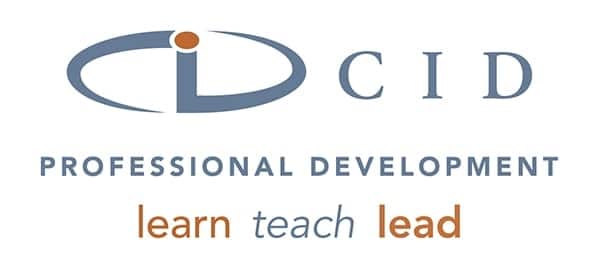
CID Professional Development
Frequently Asked Questions
View the list below for some frequently asked questions about CID’s professional resources. If you can’t find the answer you’re looking for, feel free to contact us. We’re happy to be of service!
What is your return policy on products?
You have 30 days to return your purchase in like-new condition for an exchange or refund. The purchaser will pay for the return shipping. Once CID receives the merchandise and the quality is approved, a refund will be issued. A refund can take up to 7 to 10 business days. All sales are final after 30 days. Please contact us to initiate an exchange or refund.
How can I make a purchase?
You can order directly from this website or you can send a purchase order to professionaldevelopment@cid.edu.
How can I order CID publications if I am outside of the United States?
Orders from outside of the continental United States can be placed online. Furthermore, you may place your order directly by emailing us at professionaldevelopment@cid.edu or by calling 314.977.0133 (phone), 314.977.0016 (fax). Please include the items and quantity you wish to order, the complete name and address for billing and shipment, and payment details.
*Customers are responsible for any custom fees.
How are the SPICE and SPICE for Life 2 curricula different?
They target different listening skills.
The original SPICE (Speech Perception Instructional Curriculum and Evaluation) is used for developing auditory skills in children who are at the very beginning of their auditory development. SPICE activities target the following skills:
- detection of speech
- perception of the suprasegmental aspects of speech (duration, stress and intonation)
- vowel and consonant perception
- comprehension of connected speech (phrases, sentences and conversation)
The CID SPICE for Life 2 curriculum targets development of a variety of listening skills.
- developing auditory memory
- developing auditory comprehension
- listening in noisy settings
- listening to music
- localizing sounds
- listening to voices (identify gender, emotion, etc.)
- listening in conversation
- listening on the telephone and other media
- identifying environmental sounds
For more information on this topic, visit this blog post.
How will I receive my digital access for SPICE for Life 2, ESP and ELH?
You will receive an email that will have the applicable download and/or web link. You can click directly within this document to begin the process. If the purchaser is different than the end user of the curriculum, please include that person’s name and email address within your purchase. This will allow them to receive the digital access directly.
What should I do if I have difficulty with my digital download for SPICE for Life 2, ESP or ELH?
Should you have difficulty with the download, please seek assistance from your IT department. Your organization could have firewalls and require administrative approval of the download.
Can I use SPICE for Life 2 with a student who hasn't completed the SPICE skills?
Yes.
In most cases, we recommend using both curricula with these students. This promotes well-balanced auditory development and provides variety for the student. Some SPICE for Life 2 skills, such as developing auditory memory, can also contribute to a student’s learning of language and vocabulary, allowing her to continue to make progress in the vowel and consonant perception and connected speech goals of SPICE.
Can I just order the toys from the SPICE kit or replace the ones I am missing?
No, the toys are not sold separately. The only components of the SPICE kit sold separately are the manual, rating forms and acoustic hoop.
Can I order an extra set of the SPICE picture word cards?
No, the SPICE picture word cards and sentence/nursery rhyme cards are not sold separately. The only components of the SPICE kit sold separately are the manual, rating forms and acoustic hoop.
How does CID TAGS compare to rating forms available from other organizations?
TAGS is one part of a full system for progress monitoring for listening, language and speech. It is a functional assessment that is specifically for syntax. It includes lists of grammatical structures that are commonly produced in English. The forms are a great way to keep track of what grammatical structures students are and are not using. In addition, TAGS is useful for providing data in addition to standardized test scores.
CID provides similar assessment forms for monitoring and tracking progress in all areas in which we expect delay for children with hearing loss:
- Vocabulary: CID Early Childhood Vocabulary Rating Form
- Syntax: CID TAGS (TAGS-1, TAGS-2, TAGS-3)
- Pragmatic Language: CID Preschool Pragmatic Language Rating Form
- Language Related to Play: CID Preschool Symbolic Language Rating Form
- Speech: CID Speech Skills Rating Form
- Auditory Training: CID SPICE
- Auditory Learning: CID SPICE for Life 2
Each of these forms is used in the following five ways:
- To determine a child’s present level of performance (in that area)
- To determine IEP goals (in that area)
- To determine lesson objectives (in that area)
- To track progress over time (in that area)
- To report skills and progress to parents and professionals (in that area)
When will your workshops be held?
CID hosts professional development workshops virtually each fall and spring. For dates and titles of our upcoming workshops, please click here. If you’re interested in having CID present for your staff, please contact us.
